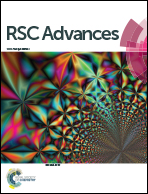Negative-capacitance and bulk photovoltaic phenomena in gallium nitride nanorods network
Abstract
An enhanced self-powered near-ultraviolet photodetection phenomenon was observed in epitaxial gallium nitride (GaN) nanorods network grown on an intermediate layer of N:GaN on a nitridated HfO2(N:HfO2)/SiO2/p-Si substrate. The fabricated Au/GaN/N:GaN/N:HfO2/Ag heterostructure exhibited a giant change (OFF/ON ratio > 50 without applying any external electrical field) in its conductance when illuminated by a very weak (25 mW cm−2) near-UV monochromatic light with a low dark current (nearly 20 nA). The presented near-UV photodetector offers photoresponsivity of ∼2.4 mA W−1 at an applied voltage of 1 V. We observed an optically generated internal open circuit voltage of ∼155 mV and short circuit current ∼430 nA, which can be attributed to the quantum confinement of free charge carriers in the nanorod matrix. Interestingly, it also shows a negative capacitance after near-UV illumination. It has great potential as a self-powered UV photodetector and in metamaterial applications.



 Please wait while we load your content...
Please wait while we load your content...